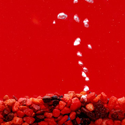Sand piles
Granular materials, like sand, seem like fluids when they are pushed lightly, but are much more resistant under a sudden impact. While this is intuitively clear, the dynamics of granular material and, in particular the formation of craters upon impact, are difficult to predict and quantify because of the complex interactions between the grains.
One way to study how craters form in sand is to drop something—like a ball—and see how large of an impression it makes. Writing in Physical Review E, Germán Varas, Valérie Vidal, and Jean-Christophe Géminard from the Université de Lyon in France are approaching the problem from a different side: they push air up through a layer of sand immersed in water and watch how craters form in the sand as the air escapes.
The setup is extremely simple: a web camera monitors the surface profile of the sand, which is confined in a picture-frame-like glass box, as air is pushed through at a constant flow rate. When the flow rate of air is low, the gas tends to bubble out of the sand, with sand replacing the space left by a bubble after it leaves. At faster flow rates, the gas passes through an essentially open channel.
The flowing air pushes sand into peaks on either side of the crater that forms where the gas emerges. Varas et al. show that the distance between these peaks increases logarithmically with time, independently of the flow rate.
Quantitative models based on these types of “table top” experiments can be of interest to geologists who are trying to understand the morphology of craters formed, on a much greater scale, by volcanoes and meteorites. – Jessica Thomas





